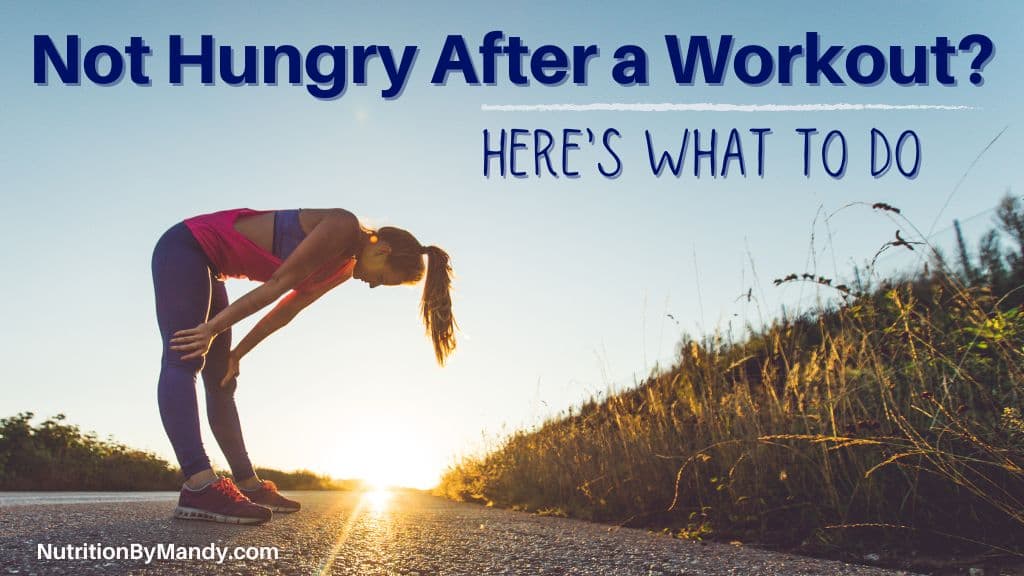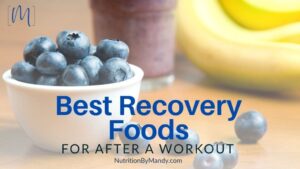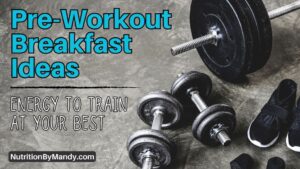Last Updated on September 28, 2025 by Mandy Tyler, M.Ed., RD, CSSD, LD
Not Hungry After a Workout? Here’s What to Do
When working with athletes, it’s common to hear that they are not hungry after a workout. They struggle to know how to meet their recovery nutrition needs when they don’t have an appetite.
Let’s explore why some athletes may not be hungry after a workout. Then I’ll share my top recommendations for what to do!
Why Am I Not Hungry After a Workout?
There are several reasons why athletes may not be hungry after a workout.
First, when athletes exercise there is a redistribution of blood flow in the body. During exercise, the body sends an increased amount of blood to the working muscles to deliver oxygen and nutrients. The body also sends an increased amount of blood to the skin to help dissipate heat (1).
To allow for the increased blood flow to the working muscles and skin, there is a reduction in blood flow to the GI tract. With the reduced blood flow to the GI tract, there is a reduction in GI function – particularly when exercising at a high intensity (1).
Impact of Hormones and Body Temperature on Appetite Post-Workout
When participating in moderate to vigorous intensity exercise, individuals experience a change in hormone levels in the body.
Although there are individual differences in hormonal responses to exercise, the changes in hormone concentrations may lead to individuals experiencing a suppression of appetite. The changes in hormone levels are transient, returning to normal levels in the hours after exercise (2).
Finally, when exercising at high intensities, particularly in a hot environment, the body’s core temperature rises. The increase in body core temperature may lead to a decrease in appetite and an athlete’s desire to eat (3).
Combined, all of these factors may lead to a suppression in appetite and an athlete not feeling hungry after a workout.
What are the Recovery Nutrition Needs of Athletes?
Before exploring what athletes should do if they are not hungry after a workout, it is important to understand what the recovery nutrition needs of athletes are.
Following a workout there are three key areas of recovery nutrition that athletes should focus on, including:
- Rehydrate: Consume fluid and electrolytes to replace sweat losses
- Refuel: Consume carbohydrates to refill energy stores
- Build and repair: Consume protein to build and repair muscles

When is Recovery Nutrition Important for Athletes?
Athletes should prioritize recovery nutrition when they have limited time (<24 hours) between exercise sessions.
This may include situations such as:
- Two-a-day workouts
- Back-to-back days of intense training sessions
- Athletes participating in school and club sports
- Tournament competitions or double-headers
What to Do When You are Not Hungry After a Workout
Now that you understand why some athletes may not be hungry after a workout and the recovery nutrition needs of athletes, let’s identify strategies for supporting athletes with refueling after a workout.
Not Hungry After a Workout: Refuel with a Nutritious Beverage
A key strategy I often share with athletes who are not hungry after a workout is to refuel with a nutritious beverage.
Although athletes may not be hungry following a workout, I find that most are thirsty and willing to drink. By choosing a nutritious, refreshing beverage post-workout athletes can support their recovery nutrition needs.
Chocolate Milk After a Workout
One of my top recovery drink options for athletes is chocolate milk. Chocolate milk is nutritious, inexpensive, and most importantly, it tastes good!
When it comes to nutrition, chocolate milk checks all three recovery nutrition boxes (4).
- Rehydrate: Chocolate milk is 90% water and a natural source of electrolytes
- Refuel: 1 cup of chocolate milk provides 26 grams of carbohydrates
- Build and repair: 1 cup of chocolate milk provides 8 grams of complete protein
In addition, chocolate milk contains calcium and Vitamin D, which are both important for supporting optimal bone health in athletes.
Pro Tip: Chocolate milk is a cost-effective option for athletes who are shopping on a budget. It is less expensive than the typical ready-to-drink protein shakes and I find most athletes prefer the taste of chocolate milk more.

Ultra-Filtered Chocolate Milk
Athletes looking to further boost their protein intake post-workout can select an ultra-filtered, high-protein milk. Ultra-filtered milks, are filtered to remove the lactose and have a concentrated protein and calcium content.
A 1-cup serving of Fairlife® ultra-filtered, chocolate milk provides 13 grams of protein. It is also lactose-free, making it a great choice for athletes who are lactose-intolerant.
Pro Tip: Along with the ultra-filtered milk I encourage athletes to enjoy some granola bars or a banana to increase their post-workout carbohydrate intake.
Not Hungry After a Workout? Try a Post-Workout Smoothie
A post-workout smoothie is another refreshing way to support athletes with meeting their recovery nutrition needs after a workout.
Athletes can build a nutrient-rich, high-carb smoothie by blending in a variety of frozen fruits and sliced banana in their drink.
To boost the protein content of their smoothie, athletes can include items such as:
- High-protein milk
- Greek yogurt
- Cottage cheese
- Dry milk
- Tofu
- Nut butter
Finally, I encourage athletes to add in a handful of leafy greens as well as chia seeds for their anti-inflammatory and gut health benefits.
Pro Tip: Make sure to visit my post-workout smoothie blog to download my athlete-approved cherry berry recovery smoothie recipe.

Not Hungry After a Workout? Plan Your Snack in Advance
An additional tip I share with athletes who are not hungry after a workout is to plan their post-workout snacks in advance.
Research shows that choosing a post-workout snack prior to exercise is an effective strategy for increasing compliance with consuming a healthy snack afterwards (5).
I encourage athletes to plan ahead and pre-commit to their post-workout snack before the training session. This will help ensure the athlete has the right food available to fuel their recovery.
In addition, it will help ensure the athlete is not relying on their appetite alone to determine what to eat post-workout.
Snack Ideas for After a Workout
Some easy snacks athletes can plan to enjoy after a workout include:
- Greek yogurt, berries, protein granola
- Granola bars, chocolate milk
- Peanut butter and jelly sandwich, low-fat milk
- Jerky, pretzels, 100% fruit juice
- Cottage cheese, pineapple, animal crackers
- Greek yogurt drink, breakfast bars
- String cheese, sliced ham, crackers, banana
Pro Tip: Athletes should follow-up their post-workout snack with a well-balanced meal within the next couple of hours. Make sure to check out my blog on dinners for athletes for a variety of easy meal ideas.

Not Hungry After a Workout? Here’s What to Do
You are now set with a variety of ideas for how to support athletes who are not hungry after a workout. Remember, planning ahead and having nutritious beverages and snacks available is key for setting athletes up for sports nutrition success.
For additional sports nutrition tips for athletes, make sure to check out my blog with ideas for what to eat before morning practice.
Join the Nutrition By Mandy Email List & Get a Free Weekly Meal Planner Template
Click HERE to join the Nutrition By Mandy e-mail list. When you join you will receive a free weekly meal planner template to download and plan out your meals for the week.
About the Author
Mandy Tyler is a Sports Dietitian Nutritionist in the San Antonio, TX area. She is a Registered and Licensed Dietitian, a Board-Certified Specialist in Sports Dietetics, a Licensed Athletic Trainer, and is a Certified Exercise Physiologist through the American College of Sports Medicine. Mandy has experience working with athletes at the high school, collegiate, and professional levels. She believes the key to reaching one’s full potential, both in everyday life and in sports performance, relies on a healthy nutritional foundation.

If you are looking to take your performance to the next level, make sure to check out my new Sports Nutrition Game Day Guide. This downloadable guide is written to help athletes develop an individualized plan to achieve peak performance on game day.





